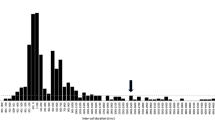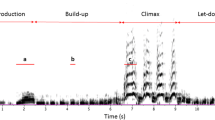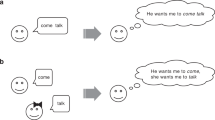Abstract
Unlike the acoustic features of calls, the temporal patterns of call usage in nonhuman primates are highly flexible. Our recent studies suggest that vocal patterns and species social needs coevolved. Different patterns, for example calling alone by producing one or several calls in a sequence or interacting vocally with more or less call overlap, may serve different functions. Vocal turn-taking in particular may be key to understanding the possible link between vocal behavior and social life. Turn-taking is used flexibly in many primate species, notably during affiliative encounters, and follows social and temporal rules that evoke similarities with human conversations. We tested the influence of caller characteristics and production context on the vocal behavior of a captive group of 15 chimpanzees using 48h30 of scan and focal sampling. 84% of the 516 recorded utterances were isolated calls. When there were vocal interactions, overlapping calls prevailed (63%), mostly involving adult males pant-hooting. Chimpanzees mostly produced calls in series, and the higher-ranked the caller, the faster the speed of call delivery. The social importance of consecutive calling was supported by a higher rate of audience reaction when the number of calls increased, suggesting strategic use of message redundancy. However, social integration, age, and sex weakly influenced call rates and interaction patterns. Although this study concerns a single study group, the rarity of turn-taking supports findings for wild chimpanzees. Why chimpanzees do not display this vocal behavior, which is commonly observed in primates, including other apes, is still puzzling.






Similar content being viewed by others
Data availability
The data generated and analyzed during the current study are available from the corresponding author on reasonable request.
References
Altmann, J. (1974). Observational study of behavior: Sampling methods. Behaviour, 49(4), 227–267. https://doi.org/10.1163/156853974X00534.
Arcadi, A. C. (2000). Vocal responsiveness in male wild chimpanzees: Implications for the evolution of language. Journal of Human Evolution, 39(2), 205–223. https://doi.org/10.1006/jhev.2000.0415.
Arlet, M., Jubin, R., Masataka, N., & Lemasson, A. (2015). Grooming-at-a-distance by exchanging calls in non-human primates. Biology Letters, 11(10), 20150711–20150714. https://doi.org/10.1098/rsbl.2015.0711.
Bascom, W. R. (1942). The principle of seniority in the social structure of the Yoruba. American Anthropologist, 44, 37–46. https://doi.org/10.1525/aa.1942.44.1.02a00050.
Bouchet, H., Pellier, A. S., Blois-Heulin, C., & Lemasson, A. (2010). Sex differences in the vocal repertoire of adult red-capped mangabeys (Cercocebus torquatus): A multi-level acoustic analysis. American Journal of Primatology, 72(4), 360–375. https://doi.org/10.1002/ajp.20791.
Cheney, D. L., Seyfarth, R. M., & Silk, J. B. (1995). The Responses of Female Baboons (Papio cynocephalus ursinus) to Anomalous Social Interactions: Evidence for Causal Reasoning? Journal of Comparative Psychology, 109(2), 134–141. https://doi.org/10.1037/0735-7036.109.2.134.
Choi, J. Y., Takahashi, D. Y., & Ghazanfar, A. A. (2015). Cooperative vocal control in marmoset monkeys via vocal feedback. Journal of Neurophysiology, 114(1), 274–283. https://doi.org/10.1152/jn.00228.2015.
Chow, C. P., Mitchell, J. F., & Miller, C. T. (2015). Vocal turn-taking in a non-human primate is learned during ontogeny. Proceedings of the Royal Society B: Biological Sciences, 282(1807), 20150069. https://doi.org/10.1098/rspb.2015.0069.
Cutting, A. L., & Dunn, J. (2006). Conversations with siblings and with friends: Links between relationship quality and social understanding. British Journal of Developmental Psychology, 24, 73–87. https://doi.org/10.1348/026151005X70337.
Da Cunha, R. G., & Byrne, R. W. (2006). Roars of black howler monkeys (Alouatta caraya): Evidence for a function in inter-group spacing. Behaviour, 143(10), 1169–1199. https://doi.org/10.1163/156853906778691568.
de Waal, F. B. M. (1982). Chimpanzee Politics. (Jonathan Cape, Ed.). London.
Digweed, S. M., Fedigan, L. M., & Rendall, D. (2007). Who cares who calls? Selective responses to the lost calls of socially dominant group members in the white-faced capuchin (Cebus capucinus). American Journal of Primatology, 69, 829–835. https://doi.org/10.1002/ajp.20398.
Dittus, W. P. J. (1984). Toque macaque food calls: Semantic communication concerning food distribution in the environment. Animal Behaviour, 32, 470–477. https://doi.org/10.1016/S0003-3472(84)80283-3.
Dohmen, D., & Hage, S. R. (2019). Limited capabilities for condition-dependent modulation of vocal turn-taking behavior in marmoset monkeys. Behavioral Neuroscience, 133(3), 320 https://psycnet.apa.org/doiLanding?doi=10.1037%2Fbne0000314.
Duffy, K. G. (2006). Social dynamics of male chimpanzees: adaptive significance of male bonds. University of California.
Dunbar, R. I. M. (1991). Functional significance of social grooming in primates. Folia Primatologica, 57, 121–131. https://doi.org/10.1159/000156574.
Dunbar, R. I. M. (1993). Coevolution of neocortical size, group size and language in humans. Behavioral and Brain Sciences, 16, 681–735. https://doi.org/10.1017/S0140525X00032325.
Dunbar, R. I. M. (1996). Grooming, gossip and the evolution of language. Faber and Faber.
Dunbar, R. I. M. (1998). The social brain hypothesis. Evolutionary Anthropology, 6(8), 178–190. .
Dunbar, R. I. M. (2009). The social brain hypothesis and its implications for social evolution. Annals of Human Biology, 36(5), 562–572. https://doi.org/10.1080/03014460902960289.
Fedurek, P., Machanda, Z. P., Schel, A. M., & Slocombe, K. E. (2013). Pant hoot chorusing and social bonds in male chimpanzees. Animal Behaviour, 86(1), 189–196. https://doi.org/10.1016/j.anbehav.2013.05.010.
Fischer, J., Kitchen, D. M., Seyfarth, R. M., & Cheney, D. L. (2004). Baboon loud calls advertise male quality: Acoustic features and their relation to rank, age, and exhaustion. Behavioral Ecology and Sociobiology, 56, 140–148. https://doi.org/10.1007/s00265-003-0739-4.
Fröhlich, M., Kuchenbuch, P., Müller, G., Fruth, B., Furuichi, T., Wittig, R. M., & Pika, S. (2016). Unpeeling the layers of language: Bonobos and chimpanzees engage in cooperative turn-taking sequences. Scientific Reports, 6(25887), 1–14. https://doi.org/10.1038/srep25887.
Fuentes, A. (1998). Re-evaluating primate monogamy. American Anthropologist, 100(4), 890–907. https://doi.org/10.1525/aa.1998.100.4.890.
Funkhouser, J. A., Mayhew, J. A., & Mulcahy, J. B. (2018). Social network and dominance hierarchy analyses at Chimpanzee Sanctuary Northwest. PlosOne, 13(2), e0191898. https://doi.org/10.1371/journal.pone.0191898.
Ghiglione, R. (1986). L’homme communiquant. (A. Colin, Ed.). Paris, France.
Golinkoff, R. M. (1986). ‘I beg your pardon?’: The preverbal negotiation of failed messages. Journal of Child Language, 21, 205–226. https://doi.org/10.1017/S0305000900006826.
Goodall, J. (1986). The Chimpanzees of Gombe: Patterns of Behvior. Belknap Press of Harvard University Press.
Gouzoules, S., Gouzoules, H., & Marler, P. (1984). Rhesus Monkey (Macaca mulata) Screams: Representational Signaliling in the Recruitment of Agonistic Aid. Animal Behaviour, 32, 182–193. https://doi.org/10.1016/S0003-3472(84)80336-X.
Graham, K. E., Hobaiter, C., Ounsley, J., Furuichi, T., & Byrne, R. W. (2018). Bonobo and chimpanzee gestures overlap extensively in meaning. PLoS Biology, 16(2). https://doi.org/10.1371/journal.pbio.2004825.
Gros-Louis, J., & Mitani, J. (1998). Chorusing and call convergence in chimpanzees: Tests of three hypotheses. Behaviour, 135(8), 1041–1064. https://doi.org/10.1163/156853998792913483.
Gruber, T., & Clay, Z. (2016). A Comparison Between Bonobos and Chimpanzees: A Review and Update. Evolutionary Anthropology, 25, 239–252. https://doi.org/10.1002/evan.21501.
Harris, T. R., Fitch, W. T., Goldstein, L. M., & Fashing, P. J. (2006). Black and white colobus monkey (Colobus guereza) roars as a source of both honest and exaggerated information about body mass. Ethology, 112(9), 911–920. https://doi.org/10.1111/j.1439-0310.2006.01247.x.
Hauser, M. D. (1996). The evolution of communication. MIT Press.
Hauser, M. D., & Marler, P. (1993). Food-associated calls in rhesus macaques (Macaca mulatta): I. Socioecological factors. Behavioral Ecology, 4(3), 194–205. https://doi.org/10.1093/beheco/4.3.194.
Henry, L., Craig, A. J. F. K., Lemasson, A., & Hausberger, M. (2015). Social coordination in animal vocal interactions. Is there any evidence of turn-taking? The starling as an animal model. Frontiers in Psychology, 6, 1416. https://doi.org/10.3389/fpsyg.2015.01924.
Janik, V. (2000). Whistle matching in wild bottelnose dolphins (Tursiops truncatus). Science, 289, 1355–1357. https://doi.org/10.1121/1.419266.
Koda, H. (2004). Flexibility and context-sensitivity during the vocal exchange of coo calls in wild Japanese macaques (Macaca fuscata yakui). Behaviour, 141(10), 1279–1296. https://doi.org/10.1163/1568539042729685.
Laporte, M. N. C., & Zuberbühler, K. (2010). Vocal greeting behaviour in wild chimpanzee females. Animal Behaviour, 80(3), 467–473. https://doi.org/10.1016/j.anbehav.2010.06.005.
Lehmann, J., & Boesch, C. (2009). Sociality of the dispersing sex: the nature of social bonds in West African female chimpanzees, Pan troglodytes. Animal Behaviour, 77, 377–387. https://doi.org/10.1016/j.anbehav.2008.09.038.
Lemasson, A., & Hausberger, M. (2004). Patterns of vocal sharing and social dynamics in a captive group of Campbell’s monkeys (Cercopithecus campbelli campbelli). Journal of Comparative Psychology, 118(3), 347–359. https://doi.org/10.1037/0735-7036.118.3.347.
Lemasson, A., Gandon, E., & Hausberger, M. (2010a). Attention to elders’ voice in non-human primates. Biology Letters, 6(3), 325–328. https://doi.org/10.1098/rsbl.2009.0875.
Lemasson, A., Ouattara, K., Bouchet, H., & Zuberbhüler, K. (2010b). Speed of call delivery is related to context and caller identity in Campbell’s monkey males. Naturwissenschaften, 97, 1–5. https://doi.org/10.1007/s00114-010-0715-6.
Lemasson, A., Guilloux, M., Rizaldi, Barbu, S., Lacroix, A., & Koda, H. (2013). Age- and sex-dependent contact call usage in Japanese macaques. Primates, 54, 283–291. https://doi.org/10.1007/s10329-013-0347-5.
Lemasson, A., Pereira, H., & Levréro, F. (2018). Social basis of vocal interactions in western lowland gorillas (Gorilla g. gorilla). Journal of Comparative Psychology, 132(2), 141–151. https://doi.org/10.1037/com0000105.
Levinson, S. C. (2016). Turn-taking in Human Communication – Origins and Implications for Language Processing. Trends in Cognitive Sciences, 20(1), 6–14. https://doi.org/10.1016/j.tics.2015.10.010.
Levréro, F., & Mathevon, N. (2013). Vocal Signature in Wild Infant Chimpanzees. American Journal of Primatology, 75(4), 324–332. https://doi.org/10.1002/ajp.22108.
Levréro, F., Touitou, S., Frédet, J., Nairaud, B., Guéry, J.-P., & Lemasson, A. (2019). Social bonding drives vocal exchanges in Bonobos. Scientific Reports, 9, 711. https://doi.org/10.1038/s41598-018-36024-9.
Manser, M. B. (2001). The acoustic structure of suricates’ alarm calls varies with predator type and the level of response urgency. Proceedings of the Royal Society B: Biological Sciences, 268(1483), 2315–2324. https://doi.org/10.1098/rspb.2001.1773.
Manser, M. B., Seyfarth, R. M., & Cheney, D. L. (2002). Suricate alarm calls signal predator class and urgency. TRENDS in Cognitive Sciences, 6(2), 55–57. https://doi.org/10.1016/S1364-6613(00)01840-4.
Masataka, N., & Biben, M. (1987). Temporal Rules Regulating Affiliative Vocal Exchanges of Squirrel Monkeys. Behaviour, 101, 311–319. https://doi.org/10.1163/156853987X00035.
McComb, K., & Semple, S. (2005). Coevolution of vocal communication and sociality in primates. Biology Letters, 1(4), 381–385. https://doi.org/10.1098/rsbl.2005.0366.
Miller, P., Shapiro, A., Tyack, P., & Solow, A. (2004). Call-type matching in vocal exchanges of free-ranging resident killer whales, Orcinus orca. Animal Behaviour, 67(6), 1099–1107. https://doi.org/10.1016/j.anbehav.2003.06.017.
Mitani, J. C. (2009). Cooperation and competition in chimpanzees: Current understanding and future challenges. Evolutionary Anthropology, 18, 215–227. https://doi.org/10.1002/evan.20229.
Mitani, J. C., & Gros-Louis, J. (1998). Chorusing and call convergence in chimpanzees: tests of three hypotheses. Behaviour, 135(9–10), 1041–1064. https://doi.org/10.1163/156853998792913483.
Mitani, J. C., & Nishida, T. (1993). Contexts and social correlates of long-distance calling by male chimpanzees. Animal Behaviour, 45(4), 735–746. https://doi.org/10.1006/anbe.1993.1088.
Muller, M. N., & Mitani, J. C. (2005). Conflict and Cooperation in Wild Chimpanzees. Advances in the Study of Behavior, 35, 275–331. https://doi.org/10.1016/S0065-3454(05)35007-8.
Nakahara, F., & Miyazaka, N. (2011). Vocal exchanges of signature whistles in bottlenose dosphins (Tursiops truncatus). Journal of Ethology, 29(2), 309–320. https://doi.org/10.1098/rspb.2011.2537.
Nishida, T. (1968). The social group of wild chimpanzees in the Mahali Mountains. Primates, 9, 167–224. https://doi.org/10.1007/BF01730971.
Ouattara, K., Lemasson, A., & Zuberbuhler, K. (2009a). Campbell’s monkeys concatenate vocalizations into context-specific call sequences. Proceedings of the National Academy of Sciences, 106, 22026–22031. https://doi.org/10.1073/pnas.0908118106.
Ouattara, K., Lemasson, A., & Zuberbühler, K. (2009b). Anti-predator strategies of free-ranging Campbell’s monkeys. Behaviour, 146, 1687–1708 https://www.jstor.org/stable/40599639.
Owren, M. J., & Rendall, D. (1997). An Affect-Conditionning Model of Nonhuman Primate Vocal Signaling. In Owings et al (Eds.), Perspective in Ethology, Volume 12 (pp. 299–346). Plenum Press.
Papworth, S., Böse, A.-S., Barker, J., Schel, A.-M., & Zuberbühler, K. (2008). Male blue monkeys alarm call in response to danger experienced by others. Biology Letters, 4, 472–475. https://doi.org/10.1098/rsbl.2008.0299.
Pika, S., Wilkinson, R., Kendrick, K. H., & Vernes, S. C. (2018). Taking turns: bridging the gap between human and animal communication. Proceedings of the Royal Society B, 285(1880), 1–9. https://doi.org/10.1098/rspb.2018.0598.
Pollick, A. S., & de Waal, F. B. M. (2007). Ape gestures and language evolution. Proceedings of the National Academy of Sciences, 104(19), 8184–8189. https://doi.org/10.1073/pnas.0702624104.
Pougnault, L. (2021). Sur les traces de l'origine de nos conversations: étude comparative des interactions vocales chez les grands singes (Doctoral dissertation, Rennes 1).
Pougnault, L., Levréro, F., & Lemasson, A. (2020a). Conversation among primate species. In N. Masataka (Ed.), The Origins of Language Revisited - Differentiation from Music and the Emergence of Neurodiversity and Autism (in press). Springer.
Pougnault, L., Levréro, F., Mulot, B., & Lemasson, A. (2020b). Breaking conversational rules matters to captive gorillas: A playback experiment. Scientific Reports, 10(1), 6947. https://doi.org/10.1038/s41598-020-63923-7.
Prieur, J., Pika, S., Barbu, S., & Blois-Heulin, C. (2016). A multifactorial investigation of captive chimpanzees’ intraspecific gestural laterality. Animal Behaviour, 116, 31–43. https://doi.org/10.1016/j.anbehav.2016.03.024.
Pusey, A., Williams, J., & Goodall, J. (1997). The influence of dominance rank on the reproductive success of female chimpanzees. Science, 277(5327), 828–831. https://doi.org/10.1126/science.277.5327.828.
Reynolds, V. (2005). The chimpanzees of the Budongo Forest. Oxford University Press.
Roberts, S. G. B., & Roberts, A. I. (2019). Social and ecological complexity is associated with gestural repertoire size of wild chimpanzees. Integrative Zoology, n/a, n/a. https://doi.org/10.1111/1749-4877.12423.
Sacks, H., Schegloff, E. A., & Jefferson, G. (1974). A Simplest Systematics for the Organization of Turn-Taking for Conversation. Language, 50, 696–735. https://doi.org/10.2307/412243.
Schel, A. M., & Zuberbühler, K. (2012). Dawn chorusing in guereza colobus monkeys. Behavioral Ecology and Sociobiology, 66(3), 361–373. https://doi.org/10.1007/s00265-011-1282-3.
Schel, A. M., Townsend, S. W., Machanda, Z., Zuberbühler, K., & Slocombe, K. E. (2013). Chimpanzee alarm call production meets key criteria for intentionality. PloS one, 8(10), e76674. https://doi.org/10.1371/journal.pone.0076674.
Scherer, K. R. (2003). Vocal communication of emotion: A review of research paradigms. Speech Communication, 40(1–2), 227–256. https://doi.org/10.1016/S0167-6393(02)00084-5.
Siegel, S., & Castellan, N. J. (1988). Nonparametric statistics for the behavioral sciences (2nd ed.). New York, NY.
Slocombe, K. E., & Zuberbühler, K. (2005). Agonistic screams in wild chimpanzees (Pan troglodytes schweinfurthii) vary as a function of social role. Journal of Comparative Psychology, 119(1), 67–77. https://doi.org/10.1037/0735-7036.119.1.67.
Slocombe, K. E., & Zuberbühler, K. (2007). Chimpanzees modify recruitment screams as a function of audience composition. Proceedings of National Academy of Sciences, 104(43), 17228–17233. https://doi.org/10.1073/pnas.0706741104.
Slocombe, K., & Zuberbühler, K. (2010). Vocal Communication in Chimpanzees. In The Mind of the Chimpanzee: Ecological and Experimental Perspectives. Chicago and London: University of Chicago Press.
Soltis, J., Leong, K., & Savage, A. (2005). African elephant vocal communication I: Antiphinal calling behaviour among affiliated females. Animal Behaviour, 70, 579–587. https://doi.org/10.1016/j.anbehav.2004.11.015.
Stern, D. N., Jaffe, J., Beebe, B., & Bennett, S. L. (1975). Vocalizing in unison and in alternation: Two modes of communication within the mother- infant dyad. Annals of the New York Academy of Sciences, 263(1), 89–100. https://doi.org/10.1111/j.1749-6632.1975.tb41574.x.
Stivers, T., Enfield, N. J., Brown, P., Englert, C., Hayashi, M., Heinemann, T., et al (2009). Universals and cultural variation in turn-taking in conversation. Proceedings of the National Academy of Sciences, 106(26), 10587–10592. https://doi.org/10.1073/pnas.0903616106.
Sugiura, H. (1993). Temporal and Acoustic Correlates in Vocal Exchange of Coo Calls in Japanese Macaques. Behaviour, 124, 3–4. https://doi.org/10.1163/156853993X00588.
Sugiura, H. (1998). Matching of acoustic features during the vocal exchange of coo calls by Japanese macaques. Animal Behaviour, 55, 673–687. https://doi.org/10.1006/anbe.1997.0602.
Takahashi, D. Y., Fenley, A. R., Teramoto, Y., Narayanan, D. Z., Borjon, J. I., Holmes, P., & Ghazanfar, A. A. (2015). The developmental dynamics of marmoset monkey vocal production. Science, 349(6249), 734–738. https://doi.org/10.1126/science.aab1058.
Thompson, M. E., Muller, M. N., Machanda, Z. P., Otali, E., & Wrangham, R. W. (2020). The Kibale Chimpanzee Project: Over thirty years of research, conservation, and change. Biological Conservation, 252, 108857. https://doi.org/10.1016/j.biocon.2020.108857.
Townsend, S. W., Deschner, T., & Zuberbühler, K. (2008). Female chimpanzees use copulation calls flexibly to prevent social competition. PLoS One, 3(6), e2431. https://doi.org/10.1371/journal.pone.0002431.
van Lawick-Goodall, J. (1968). The Behaviour of free-living chimpanzees in the Gombe Stream Reserve. Animal Behaviour Monographs, 1(3), 165–311. https://doi.org/10.1016/S0066-1856(68)80003-2.
Wilson, M. L., Hauser, M. D., & Wrangham, R. W. (2001). Does participation in intergroup conflict depend on numerical assessment, range location, or rank for wild chimpanzees? Animal Behaviour, 61(6), 1203–1216. https://doi.org/10.1006/anbe.2000.1706.
Yoshida, S., & Okanoya, K. (2005). Evolution of turn-taking: a bio-cognitive perspective. Cognitive Studies: Bulletin of Japanese Cognitive Science Society, 12(3), 153–165. https://doi.org/10.11225/jcss.12.153.
Zumpe, D., & Michael, R. P. (1986). Dominance index: A simple measure of relative dominance status in primates. American Journal of Primatology, 10, 291–300. https://doi.org/10.1002/ajp.1350100402.
Acknowledgments
The authors are deeply grateful to the ZooParc de Beauval and the chimpanzee caregivers for their valuable assistance. They also warmly thank Katie Collier for correcting our English. This work was financially supported by a CIFRE grant (#2018_00074) funded by the Association Beauval Nature pour la Conservation et la Recherche, Centre National de la Recherche Scientifique, Rennes 1 University and Lyon/Saint-Etienne University. We are also very grateful to the two anonymous reviewers and to the editor for their helpful comments about our manuscript.
Author information
Authors and Affiliations
Contributions
LP, AL, BM, and FL conceived, designed, and coordinated the study. LP collected data and performed the statistical analyses. LP, AL, and FL interpreted and drafted the manuscript. All authors gave final approval for publication and agree to be held accountable for the work performed therein.
Corresponding author
Ethics declarations
Competing interest
The authors declare no competing interests.
Additional information
Handling Editor: Joanna Setchell
Supplementary Information
ESM 1
(DOCX 94 kb)
Rights and permissions
About this article
Cite this article
Pougnault, L., Lemasson, A., Mulot, B. et al. Temporal calling patterns of a captive group of chimpanzees (Pan troglodytes). Int J Primatol 42, 809–832 (2021). https://doi.org/10.1007/s10764-021-00262-y
Received:
Accepted:
Published:
Issue Date:
DOI: https://doi.org/10.1007/s10764-021-00262-y




